
|
Olympus E-500 Image Samples |

|
My other articles related to the |
|
These are image samples from the Olympus E-500 digital camera using the two bundled "economy" zoom lenses: the 14-45/3.5-5.6 and 40-150/3.5/4.5. On the left I'm showing full frames, reduced and resharpened, with red rectangles showing locations of 1:1 samples. Those are shown on the right, without any postprocessing at all (except, of course, cropping and re-saving at low compression). All shots were taken in the native 8 MP size, and other settings follow in captions. FOcal lengths shown are actual values; to get the 35-mm equivalent ones, multiply these by two. I hope I don't have to remind you that viewing any samples on a miscalibrated monitor misses the point. Unfortunately, most of the monitors I see in homes and offices I visit fall into that category. Make sure yours does not. Another reminder: the sample height corresponds to 33 mm (1.3") in a 30x40 cm (12x16") print; the chances are that you are viewing the images magnified by two from that print size, and they will seem less sharp than they actually are. |
|
The Crofton pond, October afternoon, ISO 100 This is maybe not the best subject for image samples, but it is just next to my front door. A series of images shot with both lenses in the warm sunlight of an October afternoon. Pattern (ESP) metering was used, with -0.7 EV compensation (to protect detail in the bright house wall), and the "picture mode" was set to Vivid. First, the 14-45 mm, F/3.5-5.6 lens at various focal lengths. |
-r.jpg)
|
-f.jpg)
| |
| F = 14 mm, aperture priority (-0.7 EV): 1/1000 s at F/4, ISO 100; WB 5300K, Vivid mode, sharpness at -1, other settings at default. Here is the full frame (5MB). | ||
-r.jpg)
|
-f.jpg)
| |
| F = 18 mm, aperture priority (-0.7 EV): 1/1250 s at F/4, other settings as above. | ||
-r.jpg)
|
-f.jpg)
| |
| F = 25 mm, aperture priority (-0.7 EV): 1/1000 s at F/4.2, other settings as above. | ||
-r.jpg)
|
-f.jpg)
| |
| F = 35 mm, aperture priority (-0.7 EV): 1/800 s at F/4.9, other settings as above. | ||
-r.jpg)
|
-f.jpg)
| |
|
F = 45 mm, aperture priority (-0.7 EV): 1/500 s at F/5.6, other settings as above.
Here is the full frame (5MB). | ||
|
As mentioned, an exposure compensation of -0.7 EV was used in these pictures in order to preserve detail in the bright house wall. Looks like the new metering matrix in the E-500 does not do a smarter job here than the simpler system in the E-300, so I don't have to change my habits. All pictures were shot at (or close to) the widest aperture, where the optical performance is at its worst; as expected, the lens performs respectably here; certainly better than "economy" zooms bundled with cameras of competing brands I was able to check out, and good enough for 30×40 cm (12×16") prints. At F/8 the sharpness visibly improves, but I don't mind using full aperture. Note that in-camera sharpening was set to -1 to allow for more flexibility in postprocessing. Now similar samples for the 40-150 mm, F/3.5-4.5 lens.
|
-r.jpg)
|
-f.jpg)
| |
|
F = 40 mm, aperture priority (-0.7 EV): 1/1250 s at F/4, other settings as above.
Here is the full frame (5MB). | ||
-r.jpg)
|
-f.jpg)
| |
| F = 48 mm, aperture priority (-0.7 EV): 1/1250 s at F/4, other settings as above. | ||
-r.jpg)
|
-f.jpg)
| |
| F = 71 mm, aperture priority (-0.7 EV): 1/1250 s at F/4, other settings as above. | ||
-r.jpg)
|
-f.jpg)
| |
| F = 100 mm, aperture priority (-0.7 EV): 1/1250 s at F/4, other settings as above. | ||
-r.jpg)
|
-f.jpg)
| |
|
F = 150 mm, aperture priority (-0.7 EV): 1/1250 s at F/4.5, other settings as above.
Here is the full frame (5MB). | ||
|
No surprises here: the 40-150 mm lens performs even better than its shorter sibling — but we knew it already having tried it with the E-300. The first set of samples clearly shows that the images from the E-500 are not worse than those from the E-300 (and not better, either). This is not surprising: both cameras share the same CCD, and the lenses are the same (although different specimens were used for samples taken with both cameras). Either way, this is good news: nothing was broken. My impression is that the in-camera sharpening may be a tad lower in the E-500, which is good; still, I would recommend using the value of -1 or -2. Similarly, in high-contrast situations exposure compensation of -0.3 or -0.7 EV should be used. The new feature is the "Picture Modes", with Vivid being the default. To my eye, it provides somewhat more color saturation than I would like; in some pictures this may be pleasing, in some — exaggerated or even cheap. I would say that the Normal mode is usually a better choice. More eye candy: ISO 100, late afternoon Here are some shots from a local pumpkin patch; among the first pictures I took with the E-500. (See similar images shot with an E-300 a week earlier.) |

|
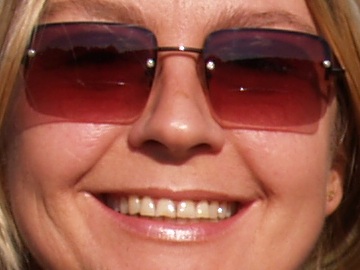
| |
| 14-45 mm lens at 24 mm, program exposure (-0.7 EV): 1/250 s at F/9, ISO 100; WB 5300K, Vivid picture mode, sharpness at -1, other settings at default. | ||

|
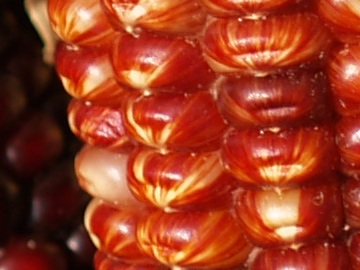
| |
| 14-45 mm lens at 45 mm, aperture priority (-0.7 EV): 1/500 s at F/5.6, ISO 100; WB 5300K, Vivid picture mode, sharpness at -1, other settings at default. | ||
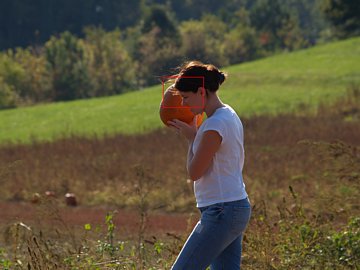
|
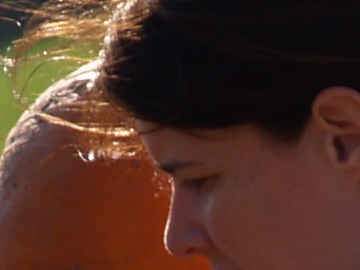
| |
| 40-150 mm lens at 150 mm, program exposure (-0.7 EV): 1/320 s at F/5.6, ISO 100; WB 5300K, Vivid picture mode, sharpness at -1, other settings at default. | ||
|
As much as I like live, vibrant colors, these are too saturated for my taste. Compare my E-300 samples shot at the same location and in similar light just a week earlier, especially the picture of my wife with the pumpkins. True, those were shot about 45 minutes earlier in the day, with the sunlight less reddish, but still; my other E-500 pictures also exhibit some oversaturation under similar circumstances. This is not really a complaint; no big deal: just switch the Picture Mode setting to Natural, but you'll have to remember to do it — unless you prefer the extra punch. Again, the computer monitor: adjust it, or else you'll be overshooting the saturation and contrast in your pictures. Anyway, I'm going to switch to the Natural picture mode for most uses, and with that I have nothing to complain about: the E-500 delivers most pleasing images. More ISO 100 samples These samples are borrowed from my comparison of standard ZD zoom lenses. The first one was shot near noon on a sunny day. As we can see, the 5300K WB setting is close to perfect here, and so is the image tonality. Two next pictures were taken early afternoon. |
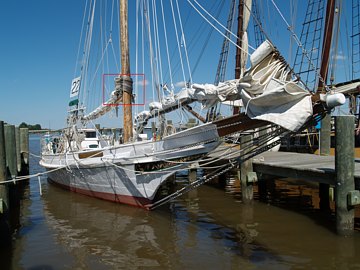
|
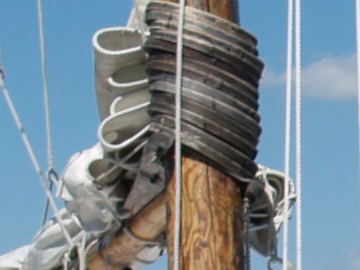
| |
| 14-45 F/3.5-5.6 ZD at 16 mm. Program exposure (-0.3 EV): 1/200 s at F/9, ISO 100, WB at 5300K; Natural picture mode, contrast at -1, sharpness at -2, saturation at 0. The full frame can be found here. | ||
.r.jpg)
|
.f.jpg)
| |
| 14-45 mm ZD at 14 mm, aperture priority (-0.3 EV): 1/1250 s at F/3.5; ISO 100, WB at 5300K. | ||
.r.jpg)
|
.f.jpg)
| |
| 14-45 mm ZD at 45 mm, aperture priority (-0.3 EV): 1/200 s at F/5.6; ISO 100, WB at 5300 K. | ||
|
Clearly, the colors and dynamic range at ISO 100 leave nothing to be desired, and the kit lens performs well: this is not a typical, cheap "kit" lens like those sold with some competing cameras (no names, please). ISO 200, 40-150 mm ZD lens Another example, shot through my patio window about 10 AM with the 40-150 mm ZD zoom lens. ISO 200 was used to avoid camera shake. This little guy hangs around our patio most of the day, but he is still a bit camera-shy. |
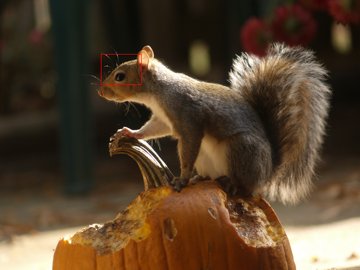
|
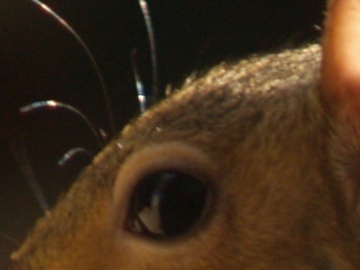
| |
| 40-150 mm lens at 118 mm, program exposure (-0.3 EV, matrix metering): 1/160 s at F/4.2, ISO 100; WB 5300K, Vivid picture mode, sharpness -2, contrast -1, other settings at default. | ||
|
Again, the colors are a bit too vivid, and I had to tone them down a little in postprocessing, which also included a slight (2%) crop, and a tad of equalization to deepen the blacks, weakened by the unavoidable lens flare and the window pane. The final result can be seen in full size here. Daylight, ISO 400 Some pictures taken at the the Maryland Eastern Shore (this is how we locals call the Maryland's part of the Delaware Peninsula, over the Cheapeake Bay from the mainland part of the state). The weather was quite windy, hence I decided to try ISO 400 to get higher shutter speeds. |
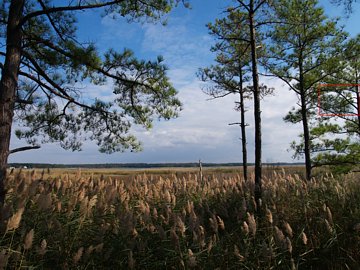
|
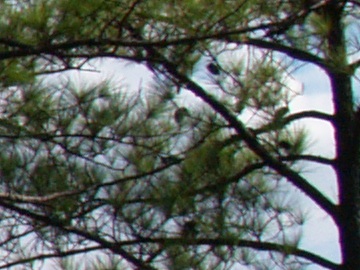
| |
| 14-45 mm lens at 14 mm, program exposure (-1 EV): 1/640 s at F/11, ISO 400; WB 5300K, Vivid picture mode, sharpness -2, contrast -1, other settings at default. | ||
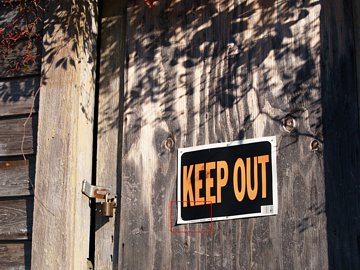
|
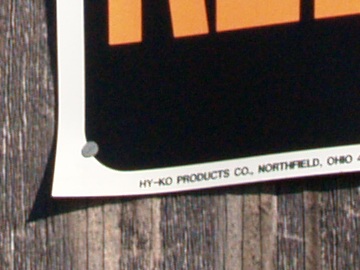
| |
| 40-150 mm lens at 40 mm, program exposure (-0.7 EV): 1/640 s at F/10, ISO 400; WB 5300K, Vivid picture mode, sharpness -2, contrast -1, other settings at default. | ||
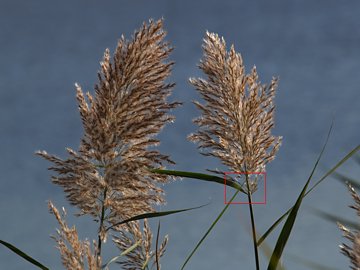
|
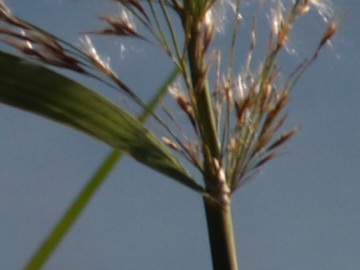
| |
| 40-150 mm lens at 150 mm, program exposure (-1.3 EV): 1/500 s at F/7.1, ISO 400; WB 5300K, Vivid picture mode, sharpness -2, contrast -1, other settings at default. | ||
|
The colors seem to be less saturated, and the dynamic range narrower than at ISO 100 (even Olympus cannot make two and two equal five), some noise visible in the sky, or even more in mid-shadows, in the 1:1 pixel viewing, but not objectionable for normal viewing or printing. The sample from the first image was chosen to show what we can expect in terms of chromatic aberration; I chose the fragment with highest contrast between dark branches and the sky; some of the effect is visible, but well under control; this is, after all, a full-size piece of an 8 MP image. Notice the readable text in the second sample — and this is with in-camera sharpening at minimum. Not bad, and not just at the price of this "economy" lens. The next examples were selected to show what you can expect regarding noise at ISO 400. |

|
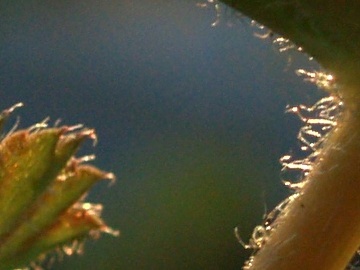
| |
| 14-45 mm lens at 40 mm, program exposure (-1 EV): 1/200 s at F/5.6, ISO 400; WB 5300K. | ||
|
I consider this a good performance: while some noise is visible in this magnification, it is not obtrusive, and it does not contain a disturbing chroma component; actually, it is close, maybe better, than in an ISO 100 negative film. At this moment I would stop worrying about noise and start thinking about other aspects: dynamic range and tonality. Anyway, if you need ISO 400, don't be afraid to use it on the E-500. Dark interior, ISO 800 This picture was taken inside a church in a small Polish town of Myszyniec. I didn't want to disturb the prayers with the tripod, so I had to resort to a higher ISO to keep the shutter speed handholdable. |
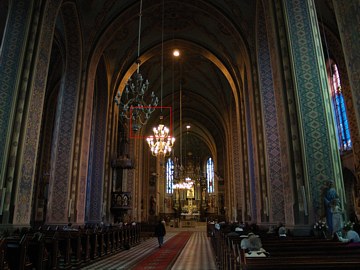
|
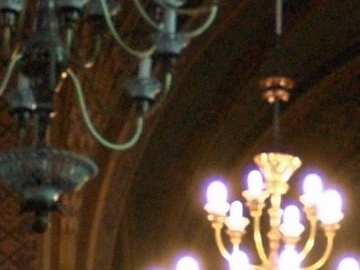
| |
| 14-45 mm lens at 14 mm, program exposure (0 EV): 1/30 s at F/3.5, ISO 800; auto WB, noise filtering on. | ||
|
While E-500 is not a high-ISO champ, I've seen worse. The noise level is, pixel for pixel, similar to that of the E-1 — and there are more pixels here, so the printed result should be somewhat better. A raw sample | |
|
For those who asked for a raw sample from the E-500, here it is. Nothing special, but enough to check for compatibility with your software. Warning: the sipped file is quite large: 10 MB, so download it only if you really need it... (Handheld, program exposure at -1 EV: 1/750 s at F/4.6, ISO 100, WB at 5300K; 40-150 mm lens at 150 mm.) |
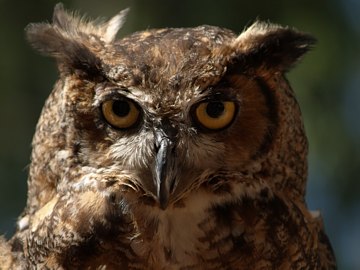
|
|
Conclusions All as expected. The E-500 produces images as good as the E-300, and this is a lot. At this moment my recommendations are to set the Picture Mode to Natural, sharpness to -2, and contrast to -1, and forget about these adjustments. With the Vivid mode (default) the colors are sometimes too saturated for my taste; the results range from pleasing to cheap or even garish. Oh, well, everything to please the mass market. Luckily, all three Picture Modes (Vivid, Natural, Muted) have and retain their own image settings — including contrast and saturation, so you may think of them as three customizable film types to choose from. Expect the best results at the lowest ISO settings, where the whole range of the sensor is utilized — this is true of all digital cameras. At 400 ISO, there is some noise visible, but nothing to stop you from making nice 30×40 cm (12×16") prints; I agree with Olympus' decision not to use more aggressive filtering. The bundled lenses are good performers, especially the 40-150 mm zoom. Update of July, 2006: After nine months with the camera I'm very happy with the results. Although I usually postprocess my images, in case of the E-500 there is usually not much to do at that stage; the pictures are most usable "as shot". If you would like to see some more results, have a look at my Anguilla Gallery. | |

|
My other articles related to the |
|
Evolt® and Olympus® are registered trademarks of Olympus Corporation.
This page is not sponsored or endorsed by Olympus (or anyone else) and presents solely the views of the author. |
| Home: wrotniak.net | Search this site | Change font size |
| Posted 2005/10/30; last updated 2006/10/14 | Copyright © 2004-2006 by J. Andrzej Wrotniak |